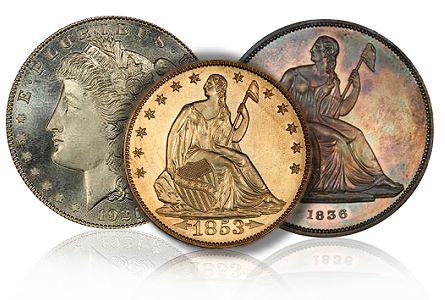By Mark Ferguson for CoinWeek – MFrarecoins.com
The rare coin market has been building strength since the immediate shock wore off from the financial meltdown that occurred during the fall of 2008. But this took a year to get started. Buyers, in general, finally began feeling comfortable spending money on rare coins during the fall of 2009. Losses in the real estate and equities markets, and expectations of inflation and a falling dollar value, have caused investors to look for alternative investments. Rare coins have emerged as a top performing and efficient investment alternative, and many investors have become experienced collectors who have gained an understanding of the coin market and profit from their knowledge. And they’re having fun with coins, as well!
 Money coming into the coin market, chasing a finite supply of rare coins, is what makes their prices rise. The coin market is now benefiting by this trend in two ways. Large numbers of people are coming to coin dealers these days to either buy or sell precious metals. They’re also reading about rare coins in financial newsletters, online, and in advertisements. In doing so, they often discover the benefits of rare coins and begin buying them. Dealers are also buying rare coins with their profits, thereby further increasing demand, and established collectors are aggressively buying quality coins as well.
Money coming into the coin market, chasing a finite supply of rare coins, is what makes their prices rise. The coin market is now benefiting by this trend in two ways. Large numbers of people are coming to coin dealers these days to either buy or sell precious metals. They’re also reading about rare coins in financial newsletters, online, and in advertisements. In doing so, they often discover the benefits of rare coins and begin buying them. Dealers are also buying rare coins with their profits, thereby further increasing demand, and established collectors are aggressively buying quality coins as well.
Currently, trading action is the heaviest in two areas of the coin market: anything related to gold and silver bullion, and high-end “premium quality” rare coins, priced from several hundred dollars on up to hundreds of thousands of dollars, and even into the millions. As a reference point, the highest price a rare coin ever sold for is $7.85 million, which occurred in May, 2010 for a presentation example of the rare 1794 silver dollar. When compared to the art market, in which record-setting paintings have sold for substantially more than $100,000,000, many experienced people in the coin market believe there is huge potential for major rarities and other rare coins to appreciate in price.
In the area related to bullion, coin dealers are buying collections and bulk coins from the public, that were mostly picked out of pocket change years before. Dealers are inventorying those coins that are worth more than the value of their precious metal content. As a result, after selling off bullion purchases, many dealers are accumulating inventories of circulated collector coins, worth more than bullion, that aren’t selling very well. A great number of middle-class collectors have been more or less cut out of active collecting because of the Great Recession.
Aside from bullion related coins, most of the trading action occurring in the coin market these days is in the high-end of the market. Premium quality coins have the spotlight right now. These are primarily coins that have been recognized by PCGS, Professional Coin Grading Service, and NGC, Numismatic Guaranty Corporation, as those rare coins that are above average quality for a grade range. They are designated by “+” signs after the grade on the labels of the grading service holders.
Another designation for premium quality coins is the oval green sticker affixed to PCGS and NGC holders by CAC, Certified Acceptance Corporation. Coins that are “stickered” as such have been determined to meet the strict standards of CAC for premium quality coins, representing above average coins in a grade range.
These coins are bringing price premiums that may be as low as 5 percent for common or “generic” coins, to as much as 50 percent more than like-kind coins of average quality. Average premiums are roughly 15 to 25 percent. Price premiums for such coins have been growing and coins stickered by CAC have been in strong demand during the past few years since the service was launched on November 1, 2007.
On the other hand, coins that don’t meet this high standard have been suffering in price and are often more difficult to sell than coins that are designated as premium quality. This is a growing problem in the rare coin market. Coins not designated as premium quality by the grading services are increasingly being looked at as inferior coins for their grades. Many buyers don’t even want them! Growing numbers of buyers these days want only coins that have been designated as premium quality. This is especially true for coins that are at the top end of the market in price and grade.
There’s also a potential for coins that don’t meet “PQ” standards to be shunned, similar to how “raw” or ungraded coins are being passed over because buyers think they may have been rejected by the grading services because of problems. Buyers want a third-party endorsement of a coin’s grade these days to protect resale values, and, in fact make them saleable.
So there’s a shortage of premium quality coins that have been designated as such by PCGS, NGC or CAC. There are two primary reasons for this. CAC has been stickering PCGS and NGC graded coins for less than four years, and PCGS and NGC have only been designating PQ coins since the spring of 2010. Simply stated – there aren’t enough premium quality coins on the market to satisfy demand. Therefore, prices are rising.
However, these price rises are not being observed by most of the major price guides. At this time, only the PCGS Price Guide and the Numismedia/NGC Price Guide recognize prices for “+” designated coins. The PCGS Price Guide listings are the most comprehensive in terms of showing the greatest number of values for + graded coins. No major price guide is recognizing prices for CAC approved coins at this time. Therefore, the price rises that are occurring today for premium quality coins are flying under the radar, so to speak. In general, coins of average quality are not appreciating at this time, and many are even falling in value because of the over shadowing demand for premium quality coins. Additionally, sales of PQ designated coins are difficult to track because there isn’t a sufficient population of these coins already graded to derive a sampling of sales data with which to establish price guide values.
There are two other trends that are affecting values for premium quality rare coins. Buyers are looking for scarcity, in other words they want coins that are difficult to replace. And then there’s a trend away from date and mintmark sets into type coins of different design types. This trend is being accentuated as prices rise. So, prices for premium quality rare coins are rising, even though most price guides aren’t recognizing this fact at this time because of the grading services fairly recent expansion into designating deserving coins as premium quality.
 Mark Ferguson was a coin grader for PCGS , a market analyst for Coin Values and has been a coin dealer for more than 40 years. He has written for the ANA, Coin Dealer Newsletter, Coin World, Numismatic News, , Coin Values, The Numismatist and currently has a weekly column on CoinWeek. Mark can be reached at Mark Ferguson Rare Coins ( www.mfrarecoins.com)
Mark Ferguson was a coin grader for PCGS , a market analyst for Coin Values and has been a coin dealer for more than 40 years. He has written for the ANA, Coin Dealer Newsletter, Coin World, Numismatic News, , Coin Values, The Numismatist and currently has a weekly column on CoinWeek. Mark can be reached at Mark Ferguson Rare Coins ( www.mfrarecoins.com)




